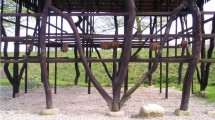Abstract
In Sweden, forest research has been emphasised on mainly two species of wood, i.e. pine and spruce. However, we have also a number of hardwoods which could be utilised for furniture manufacturing, cabinets etc. Nowadays, these hardwoods are a slumbering resource in our country. Most of our broad leafed species are found as small stands inside our soft wood forests and hence not utilised in the most profitable way. For example, much of our birch wood is ground to paper fibres even if it would be perfect for high valued veneer. Instead, most of our birch. veneer is imported from Finland. In order to increase the interest for Swedish hardwoods we therefore have started research in this field and have now designed a chair made of ash wood,Fraxinus excelsior. Most chairs are made up of structural elements called indetermined frames which makes it a rather tedious task to analyse the internal forces in the frame. However, by using the Finite Element Method, FEM, it has been possible to reduce this drawback. This paper shows how a chair could be analysed, and designed, by use of methods common in other disciplines than furniture manufacturing. We also present results, in the form of stress-strain diagrams, from tests made on Swedish ash.
Similar content being viewed by others
References
Cai, L.;Wang, F. (1993): Influence of the stiffness of corner joint on case furniture deflection. Holz Roh-Werkstoff, 51: 406–408
Eckelman, C. A. (1966): A look at the strength design of furniture, Forest Prod. J. 16 (3)
Eckelman, C. A. (1991): Effective principles of product engineering and strength design for furniture manufacturing, Purdue University, West Lafayette
Gustafsson, S. I. (1995): Furniture design by use of the finite element method, Holz RohWerkstoff, 53: 257–260
Gustafsson, S. I. (1996a): Stability problems in optimized chairs?, Wood Sci. Technol. 30: 339–345
Gustafsson, S. I. (1996b): Finite element modelling versus reality for birch chairs, Holz Roh-Werkstoff 54: 355–359
Hsieh, Y.; Mau, S. T. (1995): Elementary theory of structures, Fourth edition, Prentice-Hall Inc.
Kasal, B.; Puella, S. V. (1995): Development of analytical models for furniture, Technical report 95-01, Furniture Manufacturing and Management Center, North Carolina State University
Kollmann, F.; Côté, W. (1984): Principles of wood science and technology, Springer-Verlag
Smardzewski, J. (1992) Numeryczna optymalizacja konstrukcji krzesel, Przemysl Drzewny, No 1
Tsoumis, G. (1991): Science and technology of wood, Van Nostrad Reinhold, New York
von Adanowicz, J.;Dziegielewski, S. (1976) Prüfung und Analyse Geklebter Verbindungen an Möbeln, Holztechnologie 17(2): 97–100
Wang, S. Y.;Juang, H. B. (1994): Structural behaviour of various joints in furniture components made of softwood laminated veneer lumber, Mokuzai Gakkaishi 40(9): 911–921
Author information
Authors and Affiliations
Additional information
The author wants to thank NUTEK, the Swedish National Board for Industrial and Technical Development for financial support and professor Larsgunnar Nilsson who provided the FEM-program PCFEMP, which was used for all the calculations. Acknowledgement is also made to Bo Skoog who elaborated all testings of the wood specimens
Rights and permissions
About this article
Cite this article
Gustafsson, S.I. Optimising ash wood chairs. Wood Sci.Technol. 31, 291–301 (1997). https://doi.org/10.1007/BF00702616
Received:
Issue Date:
DOI: https://doi.org/10.1007/BF00702616




